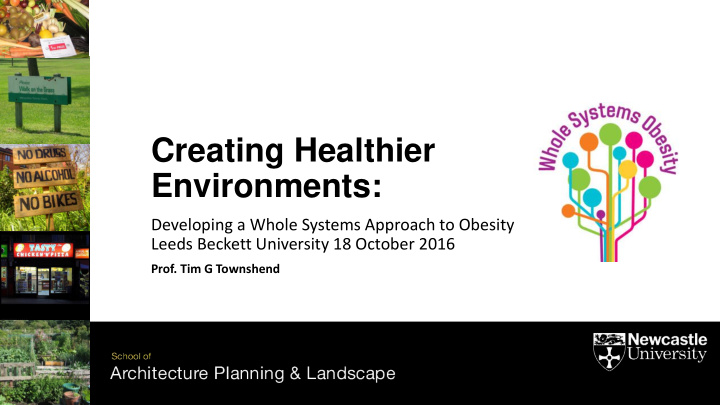



Creating Healthier Environments: Developing a Whole Systems Approach to Obesity Leeds Beckett University 18 October 2016 Prof. Tim G Townshend
Aim of today’s presentation Part 1 • Briefly overview the impact of the built environment in supporting or inhibiting healthy lifestyle choices • Consider both sides of the energy equation that leads to overweight/obesity and the built environment • Think about the ways in which planning might intervene Part 2 • Interactive workshop on planning issues
Socio-ecological model of health … so how is the built environment implicated in the obesity crisis?
Car dominated urban fabric… Metrocentre, Gateshead … at the expense of ‘active travel’ – walking and cycling
…plus • A proliferation of energy dense food/low nutrient outlets • N.B. easier and easier to order form home • So, built environment implicated on both sides of the energy (im)balance
This also links directly to health inequalities • If you live in a deprived area compared to the least deprived areas More likely to live near multiple fastfood outlets More likely to feel unsafe Children 2 x as likely to be obese Etc. etc.
Q. If its so obvious – aren’t the solutions also? A. Well of course it’s a little more complex! Moreover, reversing these trends is not straightforward – however…
Food Environments • Impact of neighbourhood food environments complex – but again multiple environments are important to consider • Some suggestions of deprivation amplification – linking poorer food access to scarcer/poorer opportunities to be active • Fast food has been a focus of planning policy for some time – with some success (not that much research on impact)
Walkable Neighbourhoods • Some aspects of neighbourhoods more important than others in supporting walking for transport • Residential density • Land-use mix • Street connectivity • Aesthetics • Safety • Some factors associated with BMI • Know more about the thresholds of some of these issue than others – e.g. residential density
Overall Physical Activity • Key issues: • Access to mixed used shops and services • High residential density • Pavements and public transport Help meet minimum guidelines • ‘Activity supportive’ e.g. cycling infrastructure = highest levels of activity • Adams et al, 2013 (11 countries) Copenhagen
Green Environments • Studies have associated greenspace proximity with increased recreational activity and inversely with BMI esp. in children • There are contradictory results – lot of unresolved issues e.g. around quality vs quantity – e.g. 40% rule of thumb • Also broader health benefits, than Parkrun just providing places for exercise – i.e. we need to think about these things more holistically
Potential of blue • Research has started to investigate the benefits of blue infrastructure • Research suggests urban blue infrastructure may have important links to wellbeing - • One study also suggested living far from usable green areas or waterfronts increase the risk of overweight • Finnish study – 2000-2008 (Halonen et al., 2014)
Emergent issues i in PA/Built Env focussed research • Multiple Environments – • Both PA and food environment research Work • Combined exposure is important – but more influential with some groups than others (e.g. Burgoine, et al 2016) • Importance of journeys – particularly Home Play active travel to school (e.g. Cooper, 2012)
Healthy alternatives… • Lots of research on allotments/community gardens etc (v positive – particularly for overall wellbeing) • They are associated with higher fruit and veg consumption • However - impact on overweight/obesity not generally measured – • Nor the impact of their shortage - Or possible cost savings to NHS with increased availability?
Positive examples… Malmo Vauban Gateshead Edinburgh
Discussion • The evidence base is far from perfect but we do know some key pieces of the jigsaw (e.g. density) – and have a good pointers about others (greenspace) • However – there is inertia in the built environment and currently there is little incentive for developers to do things differently (they go with routes of least resistance) • Moreover post-2008 some developers seem to have retreated from more progressive design • Planning policy can be developed to intervene (and has been around fast food proliferation) – but national planning policy (NPPF, 2012) is vague and much useful guidance was swept away by current government • So its all a huge challenge – but all the more reason for public health and planning to work together!
Planning Dilemmas – or ‘your mission should you choose to accept it’! • On your table you will find an envelope – in this there is a card entitled ‘planning dilemma’ – please nominate one person to read this out to the rest of the group (some are based on real situations) • There are also character cards – please take one • Now among your tables please debate the situation that has been outlined – you may go completely into your ‘character’ - if your are brave! Or simply bear in mind how this person might view the issues and reflect these in your comments • Try and allow/encourage everyone to contribute! • Try and reach a consensus agreement as to the correct way forward – you will feed this back to the whole room • The exercise shows that trying to deliver healthier places through the planning system are not always straightforward! • Please note – there is not necessarily a right or wrong answer
Many thanks for taking part – hope you enjoyed it! Developing a Whole Systems Approach to Obesity Leeds Beckett University 18 October 2016 Prof. Tim G Townshend Tim.Townshend@ncl.ac.uk
Recommend
More recommend